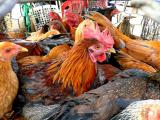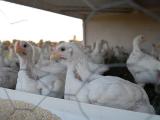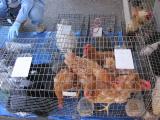A lull in the number of H7N9 cases in China has given experts a chance to sift the data to fine-tune the clinical picture of the disease, which now suggests that it is less serious than earlier assessments, with more mild infections than previously thought.
Some of the obstacles to gauging H7N9’s true severity over the past several weeks have been that many of the patients were still hospitalized and experts needed to come up with ways to make predictions about the possible number of mild infections, based on flu-like illness surveillance that was underway in some of the bigger cities in the outbreak area.
The new severity estimates are in two reports from Chinese research teams that appeared today in The Lancet. One of the studies is a clinical severity assessment that incorporates surveillance data, and the other compares the severity of H7N9 with H5N1 illness in China.
So far the new virus has sickened 131 people in China and one in Taiwan, and 39 patients have died from their infections. No new cases have been reported since May 29, and it’s not clear if the virus has died out, if poultry-market interventions stopped its spread, or if warmer weather has temporarily put a damper on H7N9 activity.
In the first study, researchers analyzed severity measures such as fatality rate, need for mechanical ventilation, and intensive-care unit admission in all lab-confirmed H7N9 infections in China, focusing on data from 123 patients who were hospitalized. They also looked at lab-confirmed H7N9 cases that were detected through sentinel flu-like illness surveillance in two of the most affected cities, Shanghai and Nanjing, which helped them estimate a denominator to better assess the overall case fatality risk.
As of May 28, 30% (37) of the hospitalized patients had died and 56% (69) had recovered. After factoring in 17 patients who were still hospitalized, the group estimated that the fatality risk for all ages was 36% upon admission to the hospital—lower than for the H5N1 virus but higher than for the 2009 H1N1 strain. The fatality risk was higher for people age 60 and older.
Earlier in the outbreak, experts aired concerns that H7N9 virus might be as lethal as the H5N1 virus.
Five lab-confirmed H7N9 cases were found in a network of 554 sentinel hospitals, which the group said signals a much larger number of mild cases. They estimated that from 1,500 to 27,000 symptomatic infections might have occurred as of May 28.
The team said their findings could help health authorities with H7N9 risk assessment and policy decisions and could help prepare for a possible new wave of human infections when cooler weather arrives.
In the second study, researchers examined and compared epidemiologic features of 130 H7N9 cases and 43 H5N1 cases that had occurred in China as of May 24, with the goal of comparing the two diseases.
They found differences, plus a few similarities. The median age of H7N9 patients was much older: 62 compared to 26 years for H5N1. The fatality rate on admission to a hospital for people infected with H7N9 was 36%, versus 70% for H5N1 patients.
The levels of exposure to poultry for patients infected with both viruses were similar, 75% for H7N9 and 71% for H5N1. For both viruses, more men were infected in urban settings compared to rural ones. The group said the pattern reflects sex-based differences in exposure rather than immunity. They noted that Shanghai had the highest ratio of infections in men, which they said could relate to Shanghai men having more frequent exposure to live poultry in retail settings. Also, they observed rural H7N9 patients typically lived on the outskirts of cities and were exposed to market poultry, rather than backyard poultry.
At 3.1 days, the incubation period for H7N9 was slightly shorter than the 3.3 days for H5N1 and was shorter then estimates made in the weeks after the virus emerged in late April. Earlier estimates put the incubation period at 7 to 10 days. The shorter incubation period has important implications for public health, they noted, urging officials to update their case definitions and close-contact surveillance protocols.
In a commentary on the two studies in the same issue of The Lancet, two epidemiology experts said estimating severity in an emerging outbreak is difficult but is urgently needed to guide response actions. The experts are Cecile Viboud, PhD, in the division of international epidemiology and population studies at the National Institute of Health’s Fogarty International Center, and Lone Simonsen, PhD, a research professor in the Department of Global health at George Washington University.
As was true for early severity estimates for the 2009 H1N1 virus, estimates for H7N9 will be refined as the outcomes of all hospitalized patients are learned and as serologic studies flesh out attack rates, the two wrote.
Though the findings of the second study comparing H7N9 and H5N1 are reassuring, showing H7N9 as a milder disease, making a prediction about a pandemic scenario is impossible, Viboud and Simonsen noted.
The studies raise questions about what would happen to the age distribution if the virus gained the ability to spread more easily from human to human. The current pattern with H7N9 appears to reflect behavior differences in animal exposures, but in a pandemic situation, the age distribution could shift toward younger people, which might skew the case-fatality rate or evolve in other unpredictable ways, based on genetic drift.
They wrote that the new severity estimates are the best so far. “However, public health experts will have to make policy decisions on the basis of uncomfortably broad confidence limits.”
Yu H, Cowling BJ, Feng L, et al. Human infection with avian influenza A H7N9 virus: an assessment of clinical severity. Lancet 2013 Jun 24 [Abstract]
Cowling BJ, Jin L, Lau EHY, et al. Comparative epidemiology of human infections with avian influenza A H7N9 and H5N1 viruses in China: a population-based study of lab-confirmed cases. Lancet 2013;Jun 24 [Abstract]
Viboud C, Simonsen L. Timely estimates of influenza A H7N9 severity. (Commentary) Lancet 2013; Jun 24 [Extract]




















